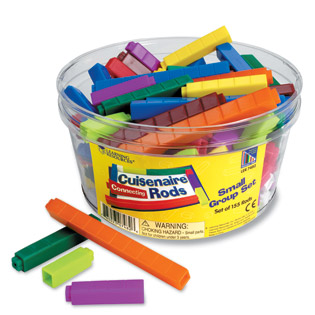7 Excellent Exercises to Improve ESL Intonation and Stress


If you are an ESL or EFL teacher, you must have heard about Cuisenaire Rods. Not many of you know the correct spelling though (I had to google it myself :)). The word is pronounced ['kwi-zi-nea].
Even though almost every English teacher has heard the name of this nice tool, there has been very little information about how to actually use Cuisenaire rods to teach English.
Cuisenaire Rods have been an essential tool in promoting hands-on learning. These wooden rods have become quite popular with English teachers in the last 10 years, and are easy to use and fun. They were invented by a Belgian primary teacher Georges Cuisenaire (1891-1976).
Normally, the set includes 10 rods of different length, from 1cm to 10cm. Rods of equal length have the same color. Thus, every set contains 10 different lengths and 10 different colors. Some manufacturers produce connecting or even magnetic rods, so that you or your students can use them on any metal surface.
Here's 15 effective ways and tips that will help you make the most of them.
 Teaching Sentence Structure
Teaching Sentence Structure
Use Cuisenaire rods to make a sentence. Assign different color to each part of speech (verb is blue, noun is white, adjective is yellow, etc).
Have students come up with examples of their own sentences that follow the same structure. Or shuffle the rods and ask Ss to re-create the original sentence. This method of teaching sentence structure allows students to focus on the sentence while figuring out what place in the sentence different parts can take.
Drilling becomes more fun, because it now involves a 'physical' act of replacing a rod in a 'sentence' made of rods.
 Teaching Sentence Stress
Teaching Sentence Stress
With your students, drill a sentence made of equal-sized Cuisenaire rods. Now replace one rod at a time with a bigger one, and read the sentence with the stress shifted to that word represented by the bigger rod. Ask students to repeat, they can also note how the meaning of the sentence can be changed by changing the stress. 'My sister is a DOCTOR'. 'My SISTER is a doctor'. 'MY sister is a doctor'. etc.
Stress can be also indicated by adding a small white rod on top of other rods.
 Teaching Word Stress
Teaching Word Stress
Each rod is a syllable - bigger rods are stresses syllables, smaller ones - reduced ones. For example, the word 'connotation' can be made up of 4 rods, the 3rd one being a bigger one because the 3rd syllable is stressed. 'Con-no-ta-tion'
 Teaching Prepositions of Position and Place
Teaching Prepositions of Position and Place
Give each pair of students a set of rods and read out the instructions about where each rod should go. Example: 'put the white rod on top of your coursebook. Place the black rod under the white rod. Put the green rod in fron of your chair.', etc. This can become fun!
Or ask your Ss to sit opposite each other and have a book or something else between them (they shouldn't see each other's workplace). Ask S1 to put his/her rods in a certain order and give instructions to S2. After s/he's finished, they can remove the obstacle and see if the instructions were followed properly.
 Teaching ABC
Teaching ABC
Start with 3 Cuisenaire rods: white is A, green is C, red is T. Ask the learners to make a word out of them.
 Teaching Colors
Teaching Colors
This is obvious - use the rods to teach what color they are. Have your students guess what color rod you're hiding behind your back (Guess my color!), or what color is missing from the set you showed them 5 seconds ago (T: What's missing? Ss: Green! Yellow! etc), or ask them to show this or that color to you ("Show me black! Show me brown!"), then ask them do the same in pairs.
 Teaching 'Size' or 'Length' Adjectives
Teaching 'Size' or 'Length' Adjectives
You can use Cuisenaire rods to teach such adjectives as 'long', 'short', 'big', 'small', 'wide', 'narrow', 'light', 'heavy', 'bright', 'fun', 'boring', 'nice', 'wooden', 'plastic', etc.
 Teaching Degrees of Comparison
Teaching Degrees of Comparison
Use 2 rods to present or elicit comparative forms (The green rod is longer/shorter/taller,brighter,heavier than the blue rod, etc). Or comparative structures such as 'The red rod is twice as long as the white one'.
Use 3 or more rods to elicit superlatives, such as (The black rod is the longest/brightest/shortest, etc).
 Teaching Wordsets
Teaching Wordsets
A lot of 'fixed' wordsets can be taught using the C. rods. For example, use different sizes to represent members of the family, or months of the year, or days of the week. Try teaching means of transportation with rods: small ones being bicycle, bigger ones - cars, the biggest - trains, etc.
 Teaching Maths Basics (Addition, Subtraction, etc)
Teaching Maths Basics (Addition, Subtraction, etc)
Put three rods on the table. Add two more. 'How many rods?'
 Teaching Parts of Speech
Teaching Parts of Speech
The words in the sentence can be colour coded to indicate the verbs, auxiliaries, endings, etc. Students can be invited to present sentences following the conventions of the colour code.
 Teaching Tenses
Teaching Tenses
Show a timeline with a series of rods, and point at the moment where the action happens. Teach Past Simple, Present Perfect, Present Continuous, Future Simple with timelines made of rods.
 Practice Weak Forms and/or Contractions
Practice Weak Forms and/or Contractions
Smaller rods indicate the words that will need to be pronounced weakly in the sentence.
 Telling Stories Using Cuisenaire Rods
Telling Stories Using Cuisenaire Rods
The teacher can easily use rods to represent a house, a table, a bed, etc. It is then possible to make one rod represent a person and to tell a simple story. For example:
This is Mr. Brown. He is opening the door. He’s going into the house. He’s turning on the light and going into the bedroom. Now he’s sitting in the armchair and taking off his shoes…
The rod story provides an easy and fun way to add more words – especially verbs – to the vocabulary list. Students can then retell the same story (in pairs or groups) or invent their own one.
 Role-Plays Using Cuisenaire Rods
Role-Plays Using Cuisenaire Rods
Students can use rods as some other objects they need for the role-play. For example, for a grocery store role-play, green rods can be cucumbers, red - tomatoes, yellow - oranges, etc. Or, for a clothes store role-play, different color rods can be clothes of those colors.
Cuisenaire Rods Advantages:
- Help to focus on the form.
- Visually appealing (bright colors).
- Kinesthetic (tactile: students can touch them).
- Lightweight and easy to transport. Can be used anythere at any time without any special equipment. Compare to OHP transparencies or electronic whiteboards!
Cuisenaire Rods Disadvantages:
- Many teachers have no idea how to use them.
- Not really suitable for certain age groups (try using them with a group of 40-year-old housewives!)
- Students may complain that instead of learning grammar they are playing with colored blocks.
In our 'electronic' world of computers, the Internet and multimedia, using wooden blocks may seem old-fashioned and even childish to some of the students (including teenagers).
It's a good idea to introduce the rods very early on in the course, while students are still getting used to your way of teaching.
In general, once students get the understanding that the rods do help them understand the structure or element you're teaching, they accept them very easily, and hardly find them strange afterwards. Just keep in mind that it would take time for them to adapt to this new teaching tool of yours.
Do you use cuisenaire rods regularly? Have you ever used them? Do you know any nice and creative or ways to use them? Please share!